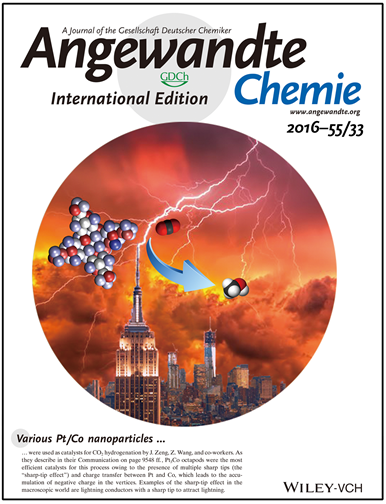Breakthrough in CO2 Hydrogenation by Applying Sharp-tip Effect
Recently, the research group of Prof. Zeng from School of Chemistry and Materials Science & Hefei National Laboratory for Physical Sciences at the Microscale has applied sharp-tip effect in CO2 hydrogenation to achieve remarkable catalytic activity by fabricating Pt3Co octapods as a catalyst. As the electron transfer to CO2 is a critical step in the activation of CO2, researchers took advantage of sharp-tip effect to engineer electronic properties of Pt3Co octapods towards CO2 hydrogenation. Multiple sharp tips enabled the accumulation of electrons on the Pt atoms in the vertices of Pt3Co octapods, contributing to the activation process of CO2. This work has been published as well as introduced as a cover and a hot paper on Angewandte Chemie International Edition (Angew. Chem. Int. Ed. 2016, 55, 9548-9552) with the title of “Pt3Co Octapods as Superior Catalysts of CO2 Hydrogenation”. Doctor Munir Ullah Khan from Pakistan, Doctor Liangbing Wang, and Doctor Zhao Liu contributed equally to this work.

Cover on Angew. Chem. Int. Ed.
The fixation and reduction of CO2 into useful chemicals and fuels has attracted tremendous interest to meet current energetic and environmental demands. Considering the high stability of a CO2 molecule, activation of CO2 plays a pivotal role in the chemical transformation of CO2. This process can be realized through heterogeneous catalysis where the catalytic performance is largely determined by the electronic properties of the surface. Based on theoretical studies, electrons are preferentially accumulated at tips and edges, which is named as sharp-tip effect. Another strategy for electronic modification is to form an alloy by adding another metal; charge transfer will then occur owing to the different electro negativities of the constituent metals.
Herein, researchers combined these two strategies to modulate the electronic properties of Pt3Co nanocrystals for enhanced catalytic performance in the CO2 hydrogenation to methanol. During CO2 hydrogenation, Pt3Co octapods exhibited the highest turnover frequency (TOF) of 758 h-1, which was 2.2, 6.1, and 6.6 times higher than that of Pt3Co nanocubes, Pt octapods, and Pt nanocubes, respectively. Such enhanced catalytic performance can be attributed to the accumulation of negative charges on the Pt atoms at the vertices of Pt3Co octapods, which was revealed by X-ray photoelectron spectroscopy (XPS) analysis and Bader charge calculations. Moreover, the activation of CO2 to form a CO2δ- intermediate was directly observed by infrared reflection absorption spectroscopy (IRRAS). This approach paves the effective way to modulate the electronic properties of catalysts to achieve superior catalytic performance.
This work was supported by MOST of China, the National Natural Science Foundation of China, etc.
Publication link: http://onlinelibrary.wiley.com/doi/10.1002/anie.201602512/full
Back
